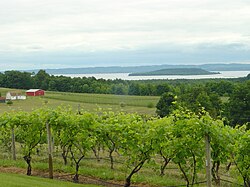| Wine region | |
 A view from Chateau Chantal on Michigan's Old Mission Peninsula | |
| Official name | State of Michigan |
|---|---|
| Type | U.S. state |
| Year established | 1837 |
| Years of wine industry | 1933-present |
| Country | United States |
| Sub-regions | Fennville AVA, Lake Michigan Shore AVA, Leelanau Peninsula AVA, Old Mission Peninsula AVA, Tip of the Mitt AVA |
| Climate region | Continental |
| Total area | 97,990 square miles (253,793 km2) |
| Size of planted vineyards | 3,375 acres (1,366 ha)[1] |
| Grapes produced | Baco noir, Cabernet Franc, Cabernet Sauvignon, Catawba, Cayuga, Chambourcin, Chancellor, Chardonnay, Concord, Gamay noir, Gewürztraminer, Kerner, Lemberger, Leon Millot, Marechal Foch, Merlot, Niagara, Pinot blanc, Pinot gris, Pinot noir, Riesling, Sauvignon blanc, Seyval blanc, Syrah, Traminette, Valiant, Vidal blanc, Vignoles[2] |
| No. of wineries | 200+ |
Michigan wine refers to any wine that is made in the state of Michigan in the United States. As of 2020, there were 3,375 acres (1,366 ha) under wine-grape cultivation[3] and over 200 commercial wineries in Michigan, producing 3 million US gallons (11,000,000 L) of wine.[4][1] According to another count there were 112 operating wineries in Michigan in 2007.[5]
Wine and enotourism were estimated in 2017 to have an economic impact of $5.4 billion,[6] up from $300 million in 2007.[1] Most of the quality bottled wine of Michigan is produced in the five American Viticultural Areas (AVAs) of Fennville AVA, Lake Michigan Shore AVA, Leelanau Peninsula AVA, Old Mission Peninsula AVA, and the Tip of the Mitt AVA. There are also a few disjunct wineries in every region of the state, including some in the Upper Peninsula that have opened over the past several years.[7] In addition to grape wine, Michigan is a leader in the production of fruit wines such as cherry wine.
- ^ a b c National Agricultural Statistics Service Michigan Field Office (2013). "Fast Facts: Michigan Wineries". United States Department of Agriculture. Archived from the original on January 29, 2014 – via Michigan Grape and Wine Industry Council.
- ^ "Michigan: Appellation Profile". Appellation America. 2007. Archived from the original on September 2, 2013.
- ^ "Michigan Craft Beverage Council Announces 2020 Grape and Hop Inventory Results". www.michigan.gov. Retrieved August 31, 2022.
- ^ "May 2022 Michigan Wine Month". www.michigan.gov. Retrieved August 31, 2022.
- ^ "Move over, California". The Economist. August 21, 2008. Archived from the original on September 24, 2020.
- ^ "Michigan Wine Industry Contributes $5.4 Billion in Economic Impact". www.winebusiness.com. Retrieved August 31, 2022.
- ^ "Michigan Wineries". Michigan By The Bottle.